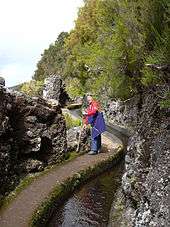Levada

A levada is an irrigation channel or aqueduct specific to the Portuguese island of Madeira.
History
The levadas originated out of the necessity of bringing large amounts of water from the west and northwest of the island to the drier southeast, which is more conducive to habitation and agriculture, such as sugar cane production. They were used in the past also by women to wash clothes in areas where running water to homes was not available. The idea of this style of water channel was brought to Portugal by the Moors during the time of al-Andalus. Similar examples can still be found in Iberia, such as some Acequias in Spain.
In the sixteenth century the Portuguese started building levadas to carry water to the agricultural regions. The most recent were made in the 1940s. Madeira is very mountainous, and building the levadas was often difficult. Many are cut into the sides of mountains, and it was also necessary to dig 25 miles (40 km) of tunnels.

Levadas today
Today the levadas not only supply water to the southern parts of the island, they also provide hydro-electric power. There are more than 1,350 miles (2,170 km) of levadas and they provide a remarkable network of walking paths. Some provide easy and relaxing walks through beautiful countryside, but others are narrow, crumbling ledges where a slip could result in serious injury or death.
A popular levada to hike is the Levada do Caldeirão Verde which continues as the Levada Caldeirão do Inferno. Altogether it is about 23 miles (37 km) long. Along both parts there are long sections which may cause hikers to suffer vertigo; and several tunnels for which flashlights and helmets are essential. The Levada do Caniçal is a much easier walk. This levada runs 7.1 miles (11.4 km) from Maroços to the Caniçal Tunnel. It is known as the mimosa levada because acacias (commonly misnamed mimosas) are found all along the route.[1]
See also
| Wikimedia Commons has media related to Levadas. |
References
- ↑ J. and P. Underwood, Landscapes of Madeira (Sunflower Books) is the most widely used guide to the levadas. It provides detailed instructions and maps covering 42 levadas and other walks.